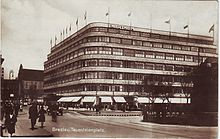Tadeusz Kościuszko Square (Wroclaw)
The Tadeusz Kościuszko Square (formerly: Tauentzienplatz , Polish: Plac Tadeusza Kościuszki ) is a square in the center of Wroclaw .
location
The square is located at the southern end of Schweidnitzer Straße . The street crosses the square in a north-south direction. The Ulica Tadeusza Kościuszki ( Tauentzien Street until 1945 ) runs east-west .
history

prehistory
In the Middle Ages, there was a cemetery for the poor and strangers on the site of today's square. The St. Gertrud Chapel also stood here . In the 16th century, the city's gallows were located here.
During the Seven Years' War , this area outside the city became important. The Prussian general Friedrich Bogislav von Tauentzien (1710-1791) was used as a commandant for the defense of the city of Breslau and took position in this area. He is reported to have said to his staff that if the battle was lost, he should die and be buried here. But the battle was won. After he died of natural causes 30 years later, he was buried in the place of his greatest triumph. Four years later, his son had a large, imposing tomb erected, which was built by Carl Gotthard Langhans and Johann Gottfried Schadow , among others . Until the city expansion after the razing of the medieval city fortifications between 1807 and 1810, this monument was outside the city area (see: Friedrich Bogislav von Tauentzien grave monument ).
Tauentzienplatz
After the demolition of the city fortifications had begun, a square parade ground, the Tauentzienplatz, was laid out from 1807 by order of Jérôme Bonaparte around the monument to the Prussian general Friedrich Bogislav von Tauentzien . In the decades that followed, the square developed into the center of the southern suburb of Wroclaw. By the end of the 19th century, it developed into one of the most beautiful in the city. Modern representative buildings were built on the square outer lines of the square, such as the Hotel Residenz built in 1861 on the northern side of the square. In 1911 the Hotel Savoy was built on the south-eastern side, and in 1913 the Dresdner Bank building on the western side of the square. The hotel residence housed from 1918 until its closure in 1929 under the name Tauentzien Theater guided Cinematography -Theater. In 1929/1930 the hotel was replaced by the Wertheim department store .
In World War II in place many houses were destroyed. Only three houses survived the war, including the Wertheim department store , the Hotel Savoy and the Dresdner Bank building.
Tadeusz Kościuszko Square
After the war, the square was named after the Polish general and national hero Tadeusz Kościuszko . The monument to Friedrich Bogislav von Tauentzien was removed. A memorial stone for the Polish soldiers who fell during the war was erected in the same place. Between 1955 and 1958, under the direction of the Polish architect Roman Dunikowskiego, five-story residential and commercial buildings in the style of socialist realism were built on the square in uniform block development . These are considered to be the first housing estate in Polish Wroclaw.
In 1994 the square was placed under monument protection. The Dresdner Bank building, built in 1913, is now used by Bank Zachodni WBK , the Wertheim department store as the Renoma department store .
Web links
- Plac Tadeusza Kościuszki (Polish)
literature
- Klaus Klöppel: Breslau - Lower Silesia and its millennial capital. Trescher Verlag, Berlin 2014, ISBN 978-3-89794-256-1 , pp. 86-87
Individual evidence
Coordinates: 51 ° 6 ′ 10.1 ″ N , 17 ° 1 ′ 47.8 ″ E



